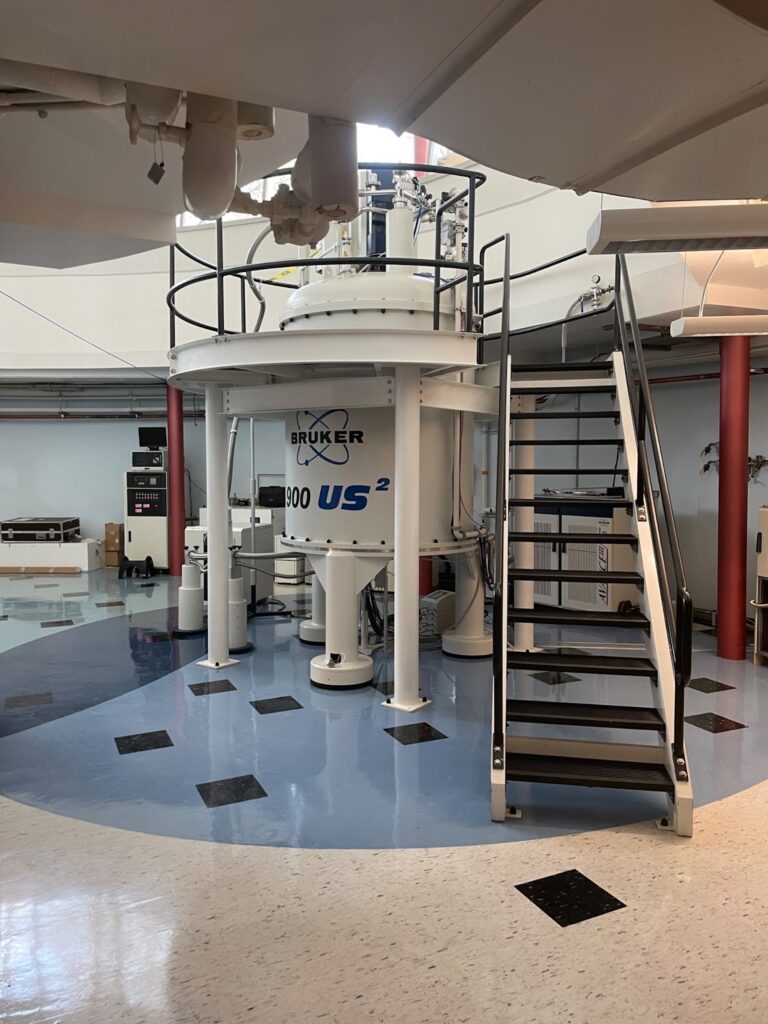The Paint and Paintbrush to Organic Chemistry’s Art!
Will Atkinson | February 26, 2023
Have you ever wondered what exactly goes on inside of the mammoth white walls of Vanderbilt’s Medical Research Building III? This daunting building – ostensibly designed for its domineering exterior – is home to perhaps the most robust and valuable collection of scientific equipment on campus. Some of these apparati are located on the ninth floor of MRB III, within the world-renowned Vanderbilt University School of Medicine Mass Spectrometry Research Center, and in Vanderbilt’s two powerful Nuclear Magnetic Resonance facilities.
Mass spectrometry and the MSRC
The Mass Spectrometry Research Core (MSRC) is home to close to 50 High Pressure Liquid Chromatography (HPLC) instruments coupled to Mass Spectrometers. Each HPLC machine costs roughly $500,000.
Mass spectrometry, which was first developed in 1912, is an analytical chemistry technique that can be used to determine the atomic makeup of a chemical sample. This is achieved by first firing a highly energized beam of electrons at an unknown chemical sample, which causes the sample to fracture. These fragments are then deflected by a magnetic field to varying degrees, depending on their mass-to-charge ratio. The degree of deflection is measured by a detector that can compute the mass-to-charge ratio of each fragment as well as their abundance. By using known masses of common intramolecular fragments, a chemist can then derive the molecular formula of the compound. Because of this capability, mass spectroscopy is a crucial tool for many researchers.
MSRC, antipsychotic drugs, and cholesterol research
One of these researchers is Dr. Keri Tallman, a research assistant professor in the Department of Chemistry. Dr. Tallman makes use of the mass spectrometers at the MSRC on a daily basis. Currently, Dr. Tallman is researching the 20-step process that leads to the synthesis of cholesterol. This 20-step (the number of steps varies by source, but Dr. Tallman follows a 20-step model) biosynthetic process is responsible for generating “slightly less than half of the cholesterol” in the body. Cholesterol deficiency can lead to hormone-related neurological disorders, while an excess can lead to the accumulation of plaque on blood vessels. Using mass spectrometry, Dr. Tallman tests how “different diseases, drugs, and toxins” have altered protein activity in patients with deficient or excess cholesterol levels by examining the actual and expected mass of the chemical intermediates produced during the biosynthetic process.
One of the main classes of drugs that Dr. Tallman investigates in her research are antipsychotic drugs. These drugs have been found to halt the synthesis of the final intermediate in the biosynthesis of cholesterol. This not only leads to a cholesterol shortage, but leaves various enzymes highly susceptible to oxidation, which can lead to dire consequences. When these drugs are used to treat psychotic patients, high levels of enzyme oxidation renders many of the drugs nonfunctional, an effect which damages lipids and is directly linked to psychiatric disorders.

The MSRC…and Nuclear Magnetic Resonance
However, the Mass Spectrometry Research Core is not the only facility that Dr. Tallman and other chemists at Vanderbilt utilize for their research. Unbeknownst to most, Vanderbilt also houses two Nuclear Magnetic Resonance facilities (Small Molecule NMR Core Facility and Biomolecular Facility) which aggregate to form one of, if not the most, powerful Nuclear Magnetic Resonance centers in the country. These centers have been notable investments: the large machine shown in the image above is a 900 MHz NMR Spectrometer with CPTCI probe which was installed in 2011 and costs about $12 million.
Nuclear Magnetic Resonance, abbreviated as NMR, is a tool used by researchers to analyze the structure of organic compounds. The machines use a large magnet to align the internal magnetic fields of atoms in a sample – most commonly carbon or hydrogen – in one of two directions. These two directions have a distinct gap in energy, which are perceived by the machine after a magnetic pulse briefly synchronizes the atoms. Through this technology, chemists are able to determine the relative location, quantity, and proximity of nearby atoms to these carbon or hydrogen atoms.
For Dr. Tallman’s research, using NMR in conjunction with mass spectrometry provides a strong method to determine the structure of every compound that she tests on her cholesterol intermediates. By doing this, she is able to analyze the interactions through the lens of both the drug and the intermediate enzyme in a stepwise manner, granting her with a high degree of precision.
“Anyone can use the mass spectrometry and NMR facilities,” Dr. Tallman explains, stating that “anytime a chemist needs a compound analyzed, they can come to the facility and get help setting up their experiment.” Having described organic chemistry as “an art,” the mass spectrometry and NMR facilities serve as essential tools to Dr. Tallman and many others’ work at Vanderbilt. Professors, researchers, and students alike “are fortunate that Vanderbilt has invested in cutting edge research tools.”
Bibliography
- Arteriosclerosis / atherosclerosis – Symptoms and causes. Mayo Clinic. [accessed 2023 Feb 12]. https://www.mayoclinic.org/diseases-conditions/arteriosclerosis-atherosclerosis/symptoms-causes/syc-20350569
- Biomolecular NMR Facility. Vanderbilt University. 2017 Apr 19 [accessed 2023 Feb 12]. https://www.vanderbilt.edu/csb/facilities/biomolecular-nmr/
- Lopez-Jimenez F. Cholesterol level: Can it be too low? Mayo Clinic. [accessed 2023 Feb 12]. https://www.mayoclinic.org/diseases-conditions/high-blood-cholesterol/expert-answers/cholesterol-level/faq-20057952
- Cholesterol: Synthesis, Metabolism, and Regulation. The Medical Biochemistry Page. 2020 [accessed 2023 Feb 12]. https://themedicalbiochemistrypage.org/cholesterol-synthesis-metabolism-and-regulation/
- Carreras H. NMR Spectroscopy Principles, Interpreting an NMR Spectrum and Common Problems. Analysis & Separations from Technology Networks. [accessed 2023 Feb 12]. http://www.technologynetworks.com/analysis/articles/nmr-spectroscopy-principles-interpreting-an-nmr-spectrum-and-common-problems-355891
- 1. Salim S. Oxidative Stress and Psychological Disorders. Current Neuropharmacology. 2014 [accessed 2023 Feb 12];12(2):140–147. https://www.ncbi.nlm.nih.gov/pmc/articles/PMC3964745/.